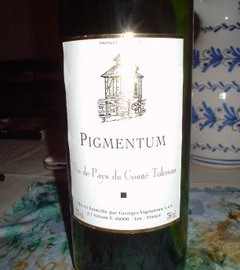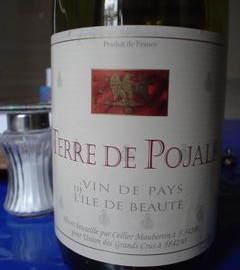I just got back from Venice. I had a short week at school last week, so on Wednesday, I got on a “fast” train and headed towards Italy. I think “fast” only means “stops infrequently” and implies nothing about speed. On te way, I saw some lovely fall foliage in the Alps. The trees turned all the colors that they turned in the mountains above the vineyards. So lovely.
Once the train crossed the border to Italy, a bunch of Italian police came on the train and demanded to see the papers of all the black people and only the black people. Cola, who might be able to pass for Italian, was spared paperwork examination on the train, but the woman sitting next to me was pulled of the train. She seemed upset. Her papers were the same kind of temporary thing I had for several weeks, which ought to enable her to travel. This extensive passport checking made our train late and we were delayed again in Milan when another set of police insisted on checking every single page of Colas’ passport. Again, I wasn’t checked. Racial profiling is apparently just fine in Italy.
Because we missed our connection, we didn’t arrive until late at night. We stayed at a hotel on Lido, the far-out island with the beaches. Venice is in a sort of a bay – they call it a lagoon – and Lido is the breakwater that keeps the water around Venice calm. I called the hotel before we left to extend our stay by one night and the guy on the phone seemed anxious to give me as much helpful information as possible (too bad he didn’t tell me when to get off the bus, though – Lido has roads and cars and stuff). In person, he was even more anxious to give information, energetically telling us anything and everything we might need to know about mealtimes, where to find cheap food, etc and demanding information in return, “um, I dunno, I just got here.”
We went back into the main part of the city and followed around other confused and hungry people until we found the one open restaurant. When I visited Venice in 2001, it was in the summer, during the high tourist season and the food was fairly awful. However, this one open restaurant made me a special off-menu serving of meatless pasta which was excellent and Cola ordered the cheapest thing on the menu and got a gigantic steak, which she said was also great. Apparently, the food has either improved in the last few years or varies according to season.
The next morning, we went to la biennale. This was the reason for our trip, as it closes on November 6th and doesn’t happen again until 2007. We spent two days looking at the art, which included many many films, but alas, not many sound installations. Some things that stick out:
A short film (maybe by Runa Islam) in the Arsenale. During the film, a woman interacted with several pieces of fine china, first by looking at it, then by using it for eating and drinking and finally by smashing it. The film looped, so when she went back to looking carefully at the china, it seemed as if she was imagining it’s destruction. “Run, teacup, run!” The film built tension in an extremely masterful way. After dropping several pieces of china, the woman began pushing, very slowly, a cup and saucer to the edge of the table. She was moving as slowly as she could and in production, the film was slowed down even further. The inevitable smashing approached, but when would it finally happen??!! In the film, her face featured very prominently at the beginning, but gradually disappeared, until you only saw her arms and hands as she destroyed all the china.
There was a film about a dog dying. It was spread across four screens that were at angles to each other. It started with a dream about the dog in New York, moved to the author’s home country and then went to Africa where dogs would howl at church bells every morning. The artist imagined this as a kind of canine prayer. It made seamless connections between dogs, dreams, prayers and death and tied fairly far afield subject matter together. What the artist did not narrate said almost more than what she did narrate.
Then there were two sets of films, once about motherhood and one about fatherhood. I think they may have been by Candice Breitz. She took a bunch of popular films, like Mommy Dearest and Kramer vs Kramer and used the to examine motherhood as it’s presented in popular culture. The films were edited so only the mother character was visible against a black background. Each mother had her own screen, making six in all. The artist grouped the words of the mothers by content and created dialogs between them about selfishness, love and other themes. Motherhood, according to popular culture is a constant battle with inadequacy. None of the women felt like they were doing enough. They had to sacrifice their sense of self. But was it really enough? Were they good mothers? Did they even have the right temperament for it, woman’s highest calling? the films about fatherhood were organized the same way, with just the main protagonist on his own screen with other people and backgrounds blacked out. She also used Kramer vs Kramer but also movies like Father of the Bride with Steve Martin and She’s Out of Control with Tony Danza (which alas, I saw at a multiplex before I was old enough to know better. In contrast to the ever-insecure mothers, the fathers believe themselves to be superdads because they make any sort of effort whatsoever. I wiped my kid’s nose, therefore I am the greatest. Fatherhood is a joke, not to be taken seriously, but if it must be for some reason, well, fathers deserve a medal. They were angry at their ex-wives for foisting this valor upon them, screaming and implying violence. The motherhood films were more powerful and that piece could have stood on it’s own, but the fatherhood half couldn’t it, it needed contrast. The visuals provided a lot of clues as to the movie and became an integral part of the work, but it could have been possible to make it a solely text piece, which would have also been nice. However the images increased the accessibility.
In the Korean Pavilion, there was another great piece with video and voice where the artist took nightly news anchors and spliced together single words to make them say things like, “With a comb and a mirror, if you have a good memory of what you look like, you can make your hair look the same as it did the day before.” and reminders to eat well and sleep adequately. Each word came from a different night of TV, but with the same anchor used for the phrases, only their clothes and the floating graphics to their right changed. The visual element was essential to this piece, which was helpfully subtitled in English.
In fact, english was everywhere. There were many many films and those that weren’t in English were subtitled in English. Signs were bilingual. The large installation on the Italian Pavilion was in English (and by an American artist.) The amount of English language stuff vastly outnumbered the amount of Italian language stuff. English is the international language of art. There’s an idea, especially in the national pavilions of the artist exploring their identity and the identity of their nation. But there’s a contrary and equally strong notion of the artist as international and transcending boundaries. This is why you get a film made by a chinese person raised in Austria talking about American (and Chinese) identity in English.
I wear my privilege on my sleeve. Why should my native tongue be the one used everywhere? Why couldn’t the English-language works have had Italian subtitles, at least? All the non-Italian speaking foreigners were speaking English to each other. I heard Germans, French folks and Italians all speaking accented English, asking about menu options and boat schedules. This not only confers an unfair advantage to English-speaking countries, it builds resentment by non-native english speakers. English is an extremely idiosyncratic, difficult language which it takes years of study to master, time that could maybe be better spent doing other things. It also will create an underclass as the European economy unifies, workers will become more migrant, like the are in the US. However, the ones that can’t speak English or the native language will be stuck in menial jobs. In the short term, the owning class might like the downward wage pressure, but in the long term, it’s a hindrance to a unified economy and it traps useful talent in the lower rungs and harms the economy overall. They should all speak an easier language which nobody speaks natively so as to make things more equal, avoid resentment and make the labor pool more mobile. Europe needs Esperanto.
But I digress… More about art and Venice coming soon.
Tags: Venice, Celesteh









